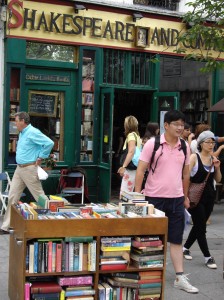Today it is overcast and cooler—perfect shopping weather– so after class I head out on a shopping mission: to purchase a green scarf that I fell in love with in a shop near the Picasso Museum; to buy another pair of black flats because the pair I bought 9 days ago are already trashed from all the walking so I need another pair for dressier occasions (and you know what they say, you can never have too many black flats); and to walk over to Ile de la Cite to the Shakespeare and Company bookstore.
I stop for a sandwich at a sidewalk café in Chatelet Les Halles then walk to the boutique Zadig and Voltaire (described as soft, feminine, bohemian rocker style chic. C’est moi—rocker style) in the Marais district. Next, I head south toward the Seine, cross the bridge to the Ile de la Cite, walk past Notre Dame Cathedral and browse at the stalls of the Left Bank booksellers along the Seine.

Bouquiniste stall on the Left Bank
Used-booksellers (bouquinistes) have been here since the mid-1500s when shops and stalls lined most of the bridges in Paris. Each bouquiniste is given four boxes and rent is paid only for the stone for which the boxes rest upon (less than 100 Euro per year). The most coveted spots are awarded by seniority. Maintenance of the boxes, including painting them a specific color of green, must be done by the bouquinistes. Because their overhead is low, you can find good prices on postcards , posters, and books. There are 250 stalls, and an eight-year waiting list for the stalls. I find a poster of the Chat Noir—the iconic poster from the 19th century caberet in Montmartre– to send to my daughter.

Le Chat Noir
Shakespeare & Company is a funky, jam-packed English language bookstore that has been visited by every well-known American writer (as well as lesser-known writers.) It is a writer’s (and reader’s) dream. At first when you enter the cramped space with floor to ceiling books, wall to wall people, and clerks frantically trying to stock the shelves as quickly as books disappear from them, it feels like chaos. But if you are in the right mood to simply browse the shelves—Russian History, French History, English Literature—it is very enjoyable. Don’t let the people squeezing by or bumping into you constantly bother you—try to get into your Zen book browsing temperament. I thought of my friend Katherine and one of her favorite sayings: “Water, water everywhere but not a drink for me.†I can’t find one book that I want to buy today. I’ll need to come back.

Shakespeare and Company
As I walk back along the Seine, there is a crowd of people (and not that I’m a fashion expert, obviously) but I notice a few fashion faux pas that I would suggest that you never (jamais) commit:
Orange clogs with tiny white shorts
A mature woman wearing a dress with a giant monkey on the front of it
A shirt worn as a dress (many stares at this fashion attempt)
Next I enter a shoe store on the Rue Rivoli with decent prices on shoes. Last week when I arrived, I discovered that despite my pre-trip planning I had brought all the wrong shoes. My red hiking shoes-impractical here. This is a city after all not the hiking trails of Jackson Hole. Most of the shoes I brought were unsuitable for the type of walking we would do–let’s just call it “advanced walking.†This is basically walking from sun up to sun down. It is not sissy walking just down the block or to the café—it is major, museum-trekking, city-traversing, not-for-amateurs walking
So on my second day, I bought a pair of black flats at a shoe store that specializes in walking shoes. I was desperate. They aren’t ugly, but they also wouldn’t be my first choice in style. They were one of the few pairs the store had in my size. E-husband (and b.f.) describes them as my grandma shoes.
Since buying the black clunkers, I have learned the most amazing thing. Walking shoes do not have to be ugly! I have become obsessed by black flat shoes. I look at women’s shoes all day and in store windows—there are hundreds of styles of adorable black flats. I need a pair of traditional looking black flats so that I don’t have to wear grandma’s clunkers every day. (the clunkers are so practical they look like they should be worn by an elderly German governess.)
Here is a current list of my shoes—it is a little embarrassing (eight pairs of shoes in Paris!).
1. Red hiking shoes: bad choice
2. Flip flops : still in suitcase
3. Black Steve Madden heels: unnecessary and impractical, still in suitcase
4. Beautiful new black flats purchased on sale for $50 in Jackson Hole, marked down from $219. These shoes will never see the streets of Paris—No I prefer that they simply take up space and weigh down my suitcase where they are pristine and safe.
5. Matronly looking black Joseph Seibel sandals: E-husband kindly pointed out that these are the same sandals worn in a Dr. Scholl’s advertisement. Feet get too dirty in sandals. Back in the suitcase they go.
6. Trashed Tuileries Shoes: Old black flats that I brought with me that I wore to the Orangerie on the pathway at the Tuileries that produces white dust that is impossible to brush off your shoes. They look like I’ve been working in a quarry. Plus they are smelly. I want to throw the in the trash but what if we want to walk through the Tuileries again—wouldn’t’ it make sense to wear the already trashed shoes instead of trashing a new pair.
7. Grandma flats (described above) Purchased once I arrived in Paris. Good practical walking shoes described above.
8. My new beautiful Paris walking shoes. Today in French Class we learned the difference between je t’aime (I love you) and j’adore (I like). J’aime little black flats! I found them on the way back from Shakespeare & Company. They are so comfortable, and cute, but again I’m afraid of ruining them. But that’s what I bought them for, right? Or maybe they should simply take up room in my suitcase too and I could buy another pair for practical black flats instead of wasting these beauties.

My new black flats
Ah, back at the apartment I check email and find the latest Fodor’s newsletter with a story: Tour Julie & Julia’s Paris: 8 Essential Stops for Your Next Visit. I looked at the list and noticed that I made it to a couple of the places already today.
From Fodor’s
Tour Julie & Julia’s Paris: 8 Essential Stops for Your Next Visit
August 12, 2009 | Posted in Tours & Itineraries
By Rachel Klein
Fodor’s Editor
If seeing Julie & Julia has inspired a trip to Paris—or if you’re already going—visiting Julia Child’s haunts will help you experience the city as she did. Some restaurants, markets, and shops below are featured in the movie, such as E. Dehillerin, where she bought kitchen supplies, and Shakespeare & Company, where she thumbed through French cookbooks. Others she writes about in her autobiography, My Life in Paris.
E. Dehillerin
Julia Child was a regular here; and this is where she’d buy kitchenware while she was attending cooking school at Le Cordon Bleu.
Visit It: E. Dehellerin has been around since 1820. Never mind the creaky stairs; their huge range of professional cookware in enamel, stainless steel, or fiery copper is gorgeous. 18–20 rue Coquillière, 1er, Louvre/Tuileries
Shakespeare & Company
Browsing here and in other bookstores in Paris, Julia came to realize that there weren’t any French cookbooks in English that would be accessible to an American audience.
Visit It: A sentimental Rive Gauche favorite, Shakespeare & Company is named after the bookstore whose American owner, Sylvia Beach, first published James Joyce’s Ulysses. Nowadays it specializes in expat literature. You can count on a couple of eccentric characters somewhere in the stacks, a sometimes-spacey staff, the latest titles from British presses, and hidden secondhand treasures in the odd corners and crannies. Poets give readings upstairs on Monday at 8 pm; there are also tea-party talks on Sunday at 4 pm. 37 rue de la Bûcherie, 5e, Quartier Latin. 01–43–25–40–93. Metro stop: St-Michel
Les Halles
Although the famous market is now gone, this is where Julia came to shop for meats and various groceries. She preferred her neighborhood marketplace on rue de Bourgogne, though, just around the corner from her apartment at 81 rue de l’Université, which she called “Roo de Loo.”
Visit It: Home to the city’s wholesale food market until the 1960s, Les Halles is still the place to go for late-night onion soup or steak frites, washed back with gulps of cheap and tasty red wine.
Faced with the unsightly 1970s shopping mall known as the Forum des Halles, it’s hard to conjure up the colors, sounds, and smells of the wholesale market that once existed here. Emile Zola dubbed Les Halles “the belly of Paris,” and although the belly has shrunk significantly since the market moved to the suburb of Rungis in 1971, it’s not completely empty. The cobblestone street market on Rue Montorgueil (open daily except Sunday afternoons and Monday) is still a feast for the senses. And some area restaurants continue to offer savory, market-inspired fare. Newcomers to Les Halles should tread carefully. A hub for 800,000 daily commuters, the area attracts chain restaurants and street hawkers. With all of the commotion, it’s easy to overlook worthy shops and eateries.
Le Grand Véfour
Julia and her husband Paul happened upon this Paris institution while exploring the Palais Royal. They visited the restaurant once a month thereafter.
Visit It: Victor Hugo could stride in and still recognize this restaurant, which was in his day, as now, a contender for the title of most beautiful restaurant in Paris. Originally built in 1784, it has welcomed everyone from Napoléon to Colette to Jean Cocteau under its mirrored ceiling, and amid the early-19th-century glass paintings of goddesses and muses that create an air of restrained seduction. Foodies as well as the fashionable gather here to enjoy chef Guy Martin’s unique blend of sophistication and rusticity, as seen in dishes such as frogs’ legs with sorrel sauce, and oxtail parmentier (a kind of shepherd’s pie) with truffles. There’s an outstanding cheese trolley and for dessert, try the house specialty, palet aux noisettes (meringue cake with chocolate mousse, hazelnuts, and salted caramel ice cream). Prices are as extravagant as the decor, but there’s an €88 lunch menu. 17 rue de Beaujolais. 01–42–96–56–27. Reservations essential; jacket and tie. AE, DC, MC, V. Closed weekends, Aug., 1 wk in Apr., 1 wk at Christmas. No dinner Fri. Metro stop: Palais-Royal.
Deux Magots
This is where Julia and Paul went on their first Saturday in Paris and ordered café complet.
Visit It: This classic café, which overlooks the St-Germain des Preés church, specializes in chocolate chaude, which is the main reason to go these days. Made with milk and pure chocolate, this hot beverage is served in a lovely white porcelain pitcher. 6 pl. St-Germain des Prés, 6e. 01–45–49–31–29.
BHV
When Julia and Paul moved into their apartment at 81 rue de l’Université, she discovered that she liked shopping and housekeeping, and didn’t mind assisting Frieda, the building’s femme de ménage (maid). It was to BHV that she’d go to buy everything from light bulbs to a garbage can.
Visit It: Short for Bazar de l’Hôtel de Ville, BHV houses an enormous basement hardware store that sells everything from doorknobs to cement mixers and has to be seen to be believed. There’s even a hardware-theme café, where how-to demos are held. The fashion offerings are limited, but BHV is noteworthy for its huge selection of high-quality household goods, home-decor material, electronics, and office supplies. If you’re looking for typically French household items (those heavy, gold-rimmed café sets, gorgeous French linen, or Savon de Marseille), this is your ticket. 52–64 rue de Rivoli, 4e, Beaubourg/Les Halles. 01–42– 74–90–00. Metro stop: Hôtel de Ville.
Marché aux Puces St-Ouen
Learning how to cook various dishes at Le Cordon Bleu meant Julia had to add special supplies to her already-full kitchen. She and Paul took a trip out to this market, where she went looking for the huge, heavy mortar and pestle needed to prepare quenelles de brochet (a Lyonnais fish dish).
Visit It: Also referred to as Clignancourt, this market on Paris’s northern boundary still attracts the crowds when it’s open—Saturday to Monday, from 9 to 6—but its once-unbeatable prices are now a relic of the past. The century-old labyrinth of alleyways packed with antiques dealers’ booths and brocante stalls sprawls for more than a square mile. Old Vuitton trunks, ormolu clocks, 1930s jet jewelry, and vintage garden furniture sit cheek by jowl. Arrive early to pick up the most worthwhile loot (like old prints). Be warned—if there’s one place in Paris where you need to know how to bargain, this is it!
If you’re arriving by métro, walk under the overpass and take the first left at the Rue de Rosiers to reach the epicenter of the market. Around the overpass huddle stands selling dodgy odds-and-ends (think pleather, knockoff shoes, and questionable gadgets). These blocks are crowded and gritty; be careful with your valuables. If you need a breather from the hundreds of market vendors, stop for a bite in one of the rough-and-ready cafés. A particularly good pick is Le Soleil (109 av. Michelet; 01–40–10–08–08).
Au Pied de Cochon
As famous a brasserie then as it is now, Julia came here—sometimes in the hours just before dawn after a night out—for their traditional onion soup.
Visit It: One of the few remnants of Les Halles’ raucous all-night past is this brasserie, which has been open every day since 1946. Now run by the Frères Blanc group, it still draws both a French and a foreign crowd with round-the-clock hours and trademark traditional fare such as seafood platters, breaded pigs’ trotters, beer-braised pork knuckle with sauerkraut, and cheese-crusted onion soup. It’s perfect ribsticking fare for a winter’s day or to finish off a bar crawl. The dining room, with its white tablecloths and little piggy details, feels resolutely cheerful. 6 rue Coquillière. 01–40–13–77–00. AE, DC, MC, V. Metro stop: Les Halles



[…] I can’t wait to see this marvel of art in this extremely crowded—yet wonderful—space. First, on my recent visit, books were stacked, shelved and piled in almost every square inch of real estate in the store. A […]
[…] on my Paris experience from last summer, I’ve worked out some of my packing problems: shoes—little black flats ready to go. Clothes—last summer was unbearably hot and I found that summer dresses were the most […]